Text
The Graveyard Below Paris: The Catacombs

(photo by Andy Delcambre)
In the late 18th century, the smell of rotting flesh was in the air... literally. Paris was in a health crisis that came from it’s former population; their cemeteries were overflowing, and it was starting to affect people's health. Especially after Paris’s largest cemetery, Les Innocents, flooded and one of their walls broke, causing dead bodies to litter the streets of Paris. Come 1786, and enough was enough - a solution had to be found. So they exhumed the bodies, and over a course of 12 years, 6 million dead people were moved to the ancient stone mining tunnels beneath Paris. It isn’t surprising that it’s thought to be one of the creepiest, most downright unsettling places in the world. It is a liminal space, where the veil gets thin and reality wavers.
The Catacombs are an incredible labyrinth, so expansive and confusing that even those who are well versed in the tunnels can, and have, gotten lost. Not only is it large, but it’s dangerous; there is the possibility of cave ins, and at the rate that secret entrances/exits get shut off, it is no easy feat to escape the parts of the tunnels that no one is allowed in. Of course, the danger pulls some people further in. The Cataphiles, as they’re called, have made it their business to discover all there is to uncover of the Catacombs. Fortunately for them, there is a lot to uncover.
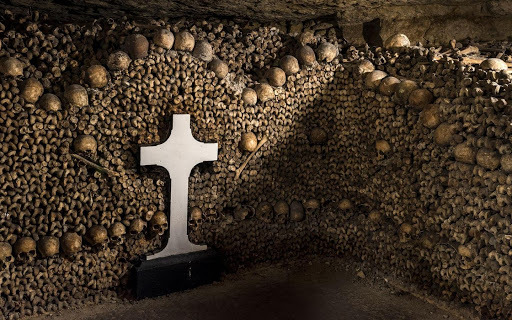
(photo from the catacombs website)
There has been many interesting things that have happened in the Catacombs, including a theater built in (without permission) and a sort of club or bar built in (also without permission). But it isn’t all fun and games; death is attracted to death, so to speak, and some terrible things have happened in this underground graveyard. Countless people have gotten lost in the endless tunnels. Some have been found, but others have not been. In some cases this means unknown missing persons, and in some cases it means another grave to be added to the collection. A case of both of these have left their mark on the Catacombs and the overall lore to the place based on real life horrors.
Philibert Aspairt, a doorman for a local hospital, entered the tunnels in search of a secret stash of liquor on November 3rd, 1973, only to end up dangerously lost. It’s thought that he wandered the underground graveyard with just one candle as light to guide him through. Once the light burnt out, though, so did his chance of escape. Aspairt died in the Catacombs, and wasn’t discovered for 11 years. They buried him in the tomb they found him in. Morbid, yet also fitting. He is the only specific ghostly presence I’ve found in my research, as he is said to wander the tunnels now. Primarily, he is known to protect the Cataphiles from the dangers of the Catacombs - namely, getting lost - but he is also known to blow out the candles of visitors, and speak in whispers into tourists’ ears, specifically on the anniversary of his death. More skin tinglingly, Aspairt is also thought to be heard calling out through the tunnels, sadly still trying to find his way out. There is a warning to not follow his voice, or you’ll end up lost too.
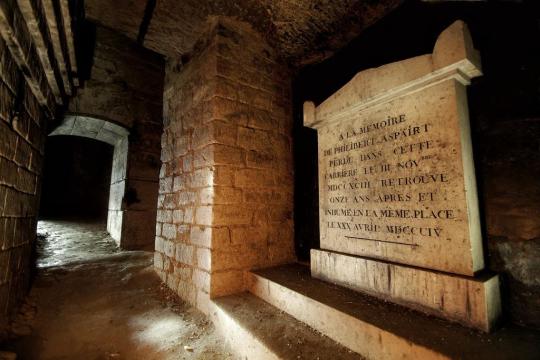
(photo by reddit user brokenbonessociety)
It’s likely that Aspairt is not the only person to have gotten lost and not been found until it was too late. In some cases, the missing people have not been found. As recently as 2010, a Cataphile exploring the forbidden areas of the underground found evidence of a person having gone missing in the tunnels. He brought it to a filmmaker that was trusted by the Cataphiles, and while it is unknown if the footage is genuine, there is also nothing indicating it isn’t. The footage shows a man wandering deep in the Catacombs, definitely beyond where he was allowed to go. It goes for a long time with the man wandering more or less aimlessly, following the occasional marker that points him in a direction that he must have been hoping was the way out. During this time, he would film details of the buried bodies, picking up bones and showing them to the camera. Eventually, though, either something externally, although unknown to the camera's view, scares him. Or, he simply snapped and the fear took him over like madness. Because the unidentified man dropped the camera and then ran off into the darkness. He didn't return, and the camera rolled until it ran out of film, with nothing else significant occurring on the tape.
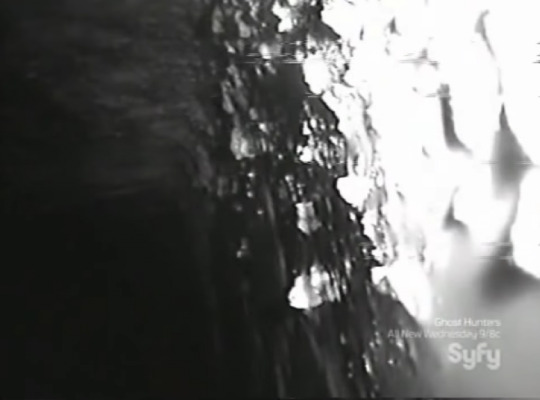
(photo from Syfy show Ghost Hunters)
The filmmaker, with the help of some Cataphile friends, adventured to the labyrinth in search of answers about the eerie footage and the man they had seen lost. While they did find parts of the path he had taken based on imagery from the video, they did not find anything that explained what came of the unknown man. The crew barely got out of the Catacombs on their search for the man, which also means they found nothing to indicate that the man could have escaped on his own. It is unlikely he had any idea how to navigate the tunnels, as none of the Cataphiles recognized the man in the footage. But with that said, the crew didn’t find his remains, either. While it may be hard to find one person’s specific remains in a place literally piled high with bones, he likely would have not been fully decayed, or he would have had more modern clothes on. This could indicate that the whole thing was faked, but there is also much of the tunnels that the crew did not go through, and its impossible to say how far the mystery man may have gone once he dropped the camera.
With all of the mysteriousness of the Catacombs, the thought of what might be down there is haunting. Amongst lore extending from true happenings, as it is with the missing people, there is another popular legend believed of the Paris Catacombs. It is said that the believably endless tunnels lead to somewhere otherworldly; specifically, that if you go far enough into the Catacombs, that you may find yourself in the upside down. Or, more simply, in Hell. It is commonly believed that the Catacombs contain the entrance to hell. With so much darkness, both metaphorical and literal, in the infinite graveyard, it leads some to imagine that something even darker exists there. Some even think that the mysterious man from the found footage may have ran straight into hell, or at the very least seen something come up from it. If not hell or a hoax, he was simply driven mad by the terrifying Catacombs.
Whether or not the Catacombs house the gates of hell, or if they are haunted, it is definitely one of the most macabre places in the world. It is overwhelmed by restless death, with dark energy that leaves some people in fear and some people addicted to risking their lives just to know what they might find in the ancient tunnels. The horrors there have lasted for centuries, and will likely continue for many more. The dead have been disrespected, starting with being uprooted from what was meant to be their final resting place. Their bones simply tossed into the underground, one enormous nameless grave for millions of people, similar to the mass graves of those that fell victim to the bubonic plague centuries before. This, as well as those who have died in modern times due to getting lost in the dilapidated tunnels. Since its start, the Catacombs have been vandalized, pieces of corpses broken and stolen, and it was even rearranged by commission from the city to be more aesthetically pleasing, years after the bodies were moved down below. Regardless of if ghosts, ghouls, or demons roam the graveyard beneath Paris, the Catacombs are surely haunted by something.
sources: Amy’s Crypt (1) (2) - Discover Walks - Sarah Winkler & Mark Boyer
#les catacombes de paris#paris catacombs#catacombes de paris#catacombs#underground tunnels#death#french lore#haunted france#hauntings in france#french hauntings#lore#french#paris#paris hauntings#hauntings in paris#my post
3 notes
·
View notes
Text
Famously Haunted: The Père Lachaise Cemetery

(photo by julia & keld)
The Père Lachaise Cemetery in Paris, France is one of the most famous cemeteries in the world, with several million visitors every year. The cemetery is even still open to receiving new permanent occupants. However, the cemetery only accepts those who died in the capital city or who lived there, and even then there’s a long waiting list; perhaps because it has been a famous cemetery for as long as it has existed. When the cemetery first opened in the early 1800’s, it started out with bodies of well known people moved there. A long history and a lot of foot traffic has left the place with a history of hauntings, and even a bizarre hoax.
But this is just why the hauntings are known. I believe the reason that it is haunted in the first place is not simply because it’s a resting place of the dead. The dead in this cemetery are particularly restless, as they are often moved around. This started with the bodies of famous people being moved to Père Lachaise to bring acclaim to the cemetery, but eventually evolved. Now that it has gained popularity and has become more crowded, some bodies get moved around inside the cemetery grounds to increase space. Family members' remains are regularly combined into the same graves. Sometimes maseuloems will house dozens of members of the same family line, with graves that can be either combined or separated by only a few inches. Shelves are even inserted to help stack as many bodies as they can fit.
The habit of reopening graves extends past just adding more family members to the same grave or mausoleum. Recently, the Père Lachaise Cemetery has offered up their eternal resting places to lease. It is standard for the cemetery to have a 30 year lease on a grave, and if the lease is not renewed by the surviving family, the body is dug up. The so-called abandoned remains are boxed up and labeled and sent to the Aux Morts Ossuary, which is still within the Père Lachaise Cemetery. It isn’t hard to imagine why the spirits here may be so active.
While the common experience of living visitors to the Père Lachaise Cemetery is an unsettling, haunted feeling, it is not just haunted in concept. There are a few ghosts that have been seen more than once, and there’s a legend that, although it is definitively a hoax, leaves people feeling a little more than strange about the cemetery.
Probably the most popular ghost of the Père Lachaise Cemetery is that of rockstar Jim Morrison, lead singer of The Doors. He went to Paris in 1971, attempting to get clean and reconnect with himself in the beautiful city. However, this trip turned tragic when he died on July 3rd. While the police report claims that his death was heart failure while at home, it is commonly believed that he overdosed because of the suspicious circumstances of the official report. If you’re interested in reading further on Jim Morrison’s time in Paris and the circumstances of his death, you can check out this article on it here. The struggle Morrison was going through before his death with his problems with drugs, alcohol and fame and the circumstances of his death itself may have led to his spirit being particularly restless, leading to sightings of his ghost at his grave. While there are plenty of mentions from people of feeling or seeing his presence when they visit his grave, the time that really led to the belief that he haunts Père Lachaise was Brett Meisner’s visit to Morrison’s grave in 1997.
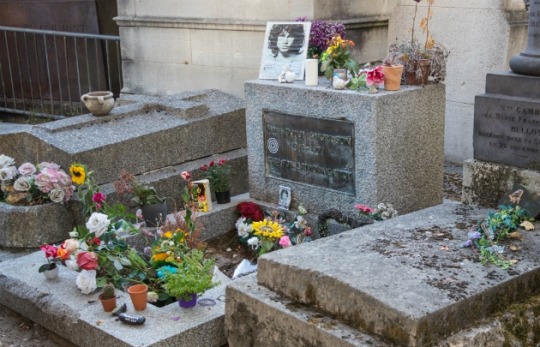
(photo from paris info website)
Brett Meisner is a rock historian, and in 1997 when he visited Jim Morrison’s resting place, he took a photo that he later felt has left a negative impact. The photo shows Meisner next to Morrison’s grave, and in the background of the image there is a human figure that has no reason to be there. It genuinely appears to be the ghost of Jim Morrison, chest bare and arms outstretched. The photo can be found with a quick Google search, but due to superstition of the photo causing a negative reaction on the people who view it, I don’t feel comfortable putting it here. Mesiner didn’t realize how astounding the image was until years later, in 2002, when he had the image authenticated. Mesiner has said since that he wishes he didn’t have the photo; that he feels it washed a negative energy over his life and has led to problems in his personal life. Not only this, but fans of Morrison who have seen the image have told Meisner that they’ve had an uneasy feeling since viewing the image, or have felt that Morrison haunts them. It’s possible that Morrison haunts not only the Père Lachaise Cemetery, but haunts through the image of his ghost as well. Morrison himself believed in ghosts, and with him dying young and possibly dying due to an overdose, it’s possible that his spirit still lingers.
Jim Morrison isn’t the only famous ghost, though. Aldolphe Theirs, a prime minister of Paris from the 19th century, is said to haunt his grave at Père Lachaise. While there are no specific first-person accounts that I could find of Theirs spooking anyone, it is generally claimed that Theirs tugs on people's clothes when they get a little too close to his tomb. This may be Theirs wanting people to keep their distance from his mausoleum, or it may just be a way of him making himself known.
The other main haunting of the Père Lachaise Cemetery is that of author Marcel Proust. It was hard to find specific actions of his hauntings, which leads me to believe that it stems from a general energy of sadness that comes from his grave. It is said that he haunts the cemetery every night in a search for his lost love. It isn’t clear who his lost love is specifically, but it is thought that they are buried in another cemetery, leaving Proust searching for his lost love forever. Considering that Proust was a closeted gay man, it is likely that this eternal search for his lost love is symbolic of the struggle with relationships he may have had in life, and the feeling of never being truly able to come together.
Although this one is not a haunting, the peculiar hoax that occured about Élisabeth Demidoff’s mausoleum deserves to be mentioned. A Russian Countess, Élisabeth Alexandrovna de Demidoff spent her last few years in Paris, and ultimately died there in 1818 at the age of 39. However, it wasn’t until 75 years later that her grave at Père Lachaise stood out amongst those laid to rest there. A posting went into papers in many places, but it seems to have primarily occurred in the United States, which has the earliest dated edition on the Chicago Daily Tribune in 1893. The posting claims that Russian Countess (sometimes Princess) Élisabeth Demidoff died only five years previous, rather than nearly a century before, and lays out a challenge to earn 5,000,000 francs: stay one whole year in her mausoleum, alone. Descriptively, it says that the person will receive no visitors, and won’t even be allowed to speak to the person that brings them food once per day. Their only activities - aside from staring at the Countess’s coffin - would be to read by the candlelight that is casted beside her (clear) coffin, and to take an hour’s stroll around the cemetery in the late evening or early morning, after the cemetery gates have been shut, thus not a living soul would be in sight. It seems the main purpose is to have this person be her watcher; there were descriptions of her mausoleum being covered in mirrors, so that anyway her watcher might look, their eyes would fall upon her preserved corpse. The article makes note that those who attempted to stay were not able to last long. Specifically, they were driven mad by not just their loneliness, but also haunting and mysterious sounds, shadows, touches, etc.
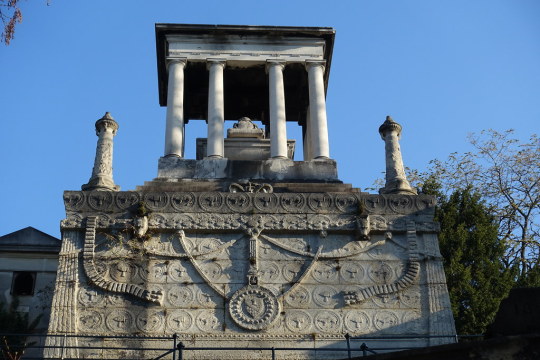
(photo by Guilhem Vellut)
While no such will ever existed, the public did fall for the peculiar prank. Following the various articles depicting this bewildering proposition, articles were released explaining the nonsense of it all. They described Paris officials and those in charge of Père Lachaise receiving letters upon letters from people across the world, although especially in America, requesting to be given the opportunity to stay in the Countess’s mausoleum and win the 5,000,000 francs. Soldiers were especially known to apply, stating how they’d spent long periods of time with little to not contact with people while vigilant in the dark. Although no real damage was done, it definitely irritated the Parisian officials. Additionally, perhaps in an attempt to continue the legend, there has since been lore about Demidoff being a vampire. This appears to only be due to symbols and inscriptions that aren’t even very identifiable on the mausoleum, and people claim the supposed symbols point to vampirism. I don’t imagine that this is something anyone believes in; rather it’s just embellishment on what is already at its base an already known lie.
Whether or not the Père Lachaise Cemetery is truly haunted, the cemetery is itself a haunting experience for visitors. The fact that the graveyard still actively takes in new residents, but that many of them have been or may be moved around, gives credence to a dark energy in the cemetery. However, even its tales of haunts aren’t too negative or distinct, which leads me to believe that Père Lachaise is more haunted in spirit than in anything truly tangible. Of course, visitors of the cemetery must decide for themselves. Its residents are the only ones who will know for sure.
sources: Amy’s Crypt (1) (2) - Bess Lovejoy - Chris Woodyard - Daniel Kreps - Discover Walks - Find A Grave - Marilyn Brouwer - Wikipedia
#pere lachaise#pere lachaise cemetery#paris#france#paris cemeteries#european cemeteries#urban legends#hauntings#haunted#french hauntings#french urban legends#parisian hauntings#jim morrison#marcel proust#my post
9 notes
·
View notes
Text
The Parisian Sweeney Todd - or, the Barber and Baker of Ile de la Cité
The famous tale, musical, and movie of Sweeney Todd may not have begun in London - rather, the legend originates from Paris, at the corner of two now nonexistent streets in the Ile de la Cité. Whether it’s a tale of fact or fiction, it seems likely that it inspired the penny dreadful about Sweeney Todd that led to the musical.
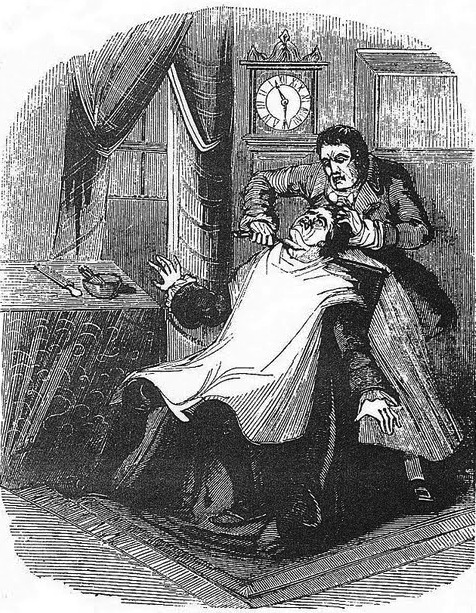
(photo from Caitlin Duffy)
In the 14th century, from the years of 1384-1387 a barber and baker in Rue de la Harpe struck a deal. The barber would slit the throats of customers, specifically foreign students who were less likely to be noticed as missing, and he would then send their bodies to a basement that he and the baker shared. The barber dismembered these bodies, and the baker made the victims into pâtisseries that are said to have been some of the most famous in Paris. They were highly sought after, and it’s said that even the King and his fellow royals loved these (human) meat pies.
But it is hard to keep a horrifying business such as theirs a secret forever. After the barber murdered a German student named Alaric, his loyal dog stationed himself outside the barbers shop, howling day and night as he awaited his owners return. Depending on the account, either the students wife found the dog and alerted the police, or they simply came because of the howling companion. From there, the baker and barber were discovered and plead guilty to their crimes and were, allegedly, burned alive in iron cages. Their crimes were so horrific that their shops were taken down as well. It’s possible that the removal of these buildings for other reasons could have sparked some the rumors of these serial killers, although perhaps they were taken down to cleanse the area of the horrific murders that had taken place there. For a period of time, a statue of the dog was in the area, but it and the shops are long gone, replaced by the Hotel Dieu.
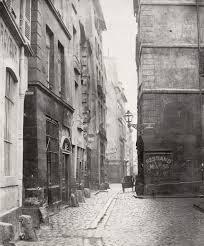
(photo by Charles Marville and MoMA)
It is unknown when this legend truly began to surface (that is to say, if it is a legend), but it certainly arose before The String of Pearls (what Sweeney Todd as we know it is based off of). However, the strongest piece of truth comes from a folk song, written the same year the butcher and barber are said to have been executed. The English translation goes:
“And rue des Deux-Hermites
near the Marmousets
were two accursed souls
by their dreadful crimes,
the bloodthirsty barber and reckless baker
discovered by a dog
making the world eat,
by fruitful cruelty
the flesh of a Christian”
It is also said that it was Joseph Fouché, the Parisian chief of police, in 1800 that documented these murders. Either way, though, The String of Pearls came after the Parisian legend, as the series was released as a penny dreadful series from 1846-47. Considering the timelines, it isn’t a stretch to consider that Sweeney Todd is based off of this Parisian legend.
sources: Discover Walks - Wikipedia - Boredom Therapy (Dylan Guy) - Wikipedia - Messy Nessy (Quinn Connors) - Culture Trip (Diana Vernon)
#the baker and barber of ile de la cite#urban legends#sweeney todd#penny dreadful#the string of pearls#paris#france#urban legends of paris#parisian urban legends#french urban legends#lore#french lore#french#serial killers#victorian serial killers#my post
13 notes
·
View notes
Text
Royally Haunted: The Palace of Versailles
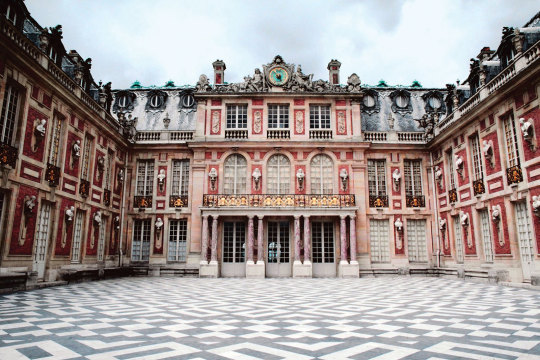
the marble court (source: jupiter’s images / britannica)
The Palace of Versailles is famous for being a residence of French royalty, but most especially for housing King Louis XVI and Queen Marie Antoinette up until the French Revolution saw them both killed. Although it is now a museum, itself belonging to history, it also appears to hold more than just paintings and fancy furniture; it holds lore.
Marie Antoinette is the most commonly sighted spirit to haunt this residence. She’s seen anywhere from Le Petit Trianon, her royal residence, to the concierge area in which she was held before her death in 1793. She is often seen in the palace and in the gardens, too, though most often she is seen in her bedroom inside the Petit de Trianon. In the Queen’s residence, it is said that temperatures drop sharply, unexplainable mists occur, and general “poltergeist activity” is experienced by visitors. All of this is believed to be sourced back to the Queen.

petit de trianon (source: domart on flickr)
Although Marie Antoinette is most commonly sighted, other spirits have been seen at Versailles. Notably, King Louis XVI has been seen to wander the halls of the palace, looking thoughtful until he disappears at being noticed. Benjamin Franklin, who visited the Palace of Versailles while in France on behalf of a young America, has also been seen. In Le Grand Trianon, Napoleon Bonaparte and Charles de Gaulle have occasionally been sighted.
In terms of a particular event, two young academic women visited the Palace of Versailles in 1901. During their visit, they claim to have been thrown into a time glitch, or otherwise a very specific haunting experience. While wandering through the garden of the Petit de Trianon, the two girls began experiencing an overwhelming feeling of dread, and a strange energy. They encountered people in old-fashioned clothes that they later determined to be fashion of the 1790s. Not only did they witness these folk, and a man riddled with smallpox, but they believe they saw the Queen herself - Marie Antoinette, drawing in her garden. All of this could be explained by reenactments, which did take place at the palace itself (although none were scheduled during the time the girls visited). However, the fact that they ended up on trails and saw buildings that existed in the 1700s, but not during their time, lends towards the idea that perhaps something spooky did happen that day.
Although there is nothing that confirms the supernatural having a place at the Palace of Versailles, it is true that the Palace holds a strong place in the history of France. Perhaps it is this fact that lends towards the lore of the Palace - a place so old, and so eventful, cannot escape dark energy plaguing it. It’s possible that the Palace staying so immaculately true to its history may lend a hand in bringing in spirits and making them more pronounced. Who wouldn’t want to spend eternity in a place so grand?
sources: Diana Brown - Amy’s Crypt
#palace of versailles#marie antoinette#king louis xvi#french hauntings#french lore#french urban legends#french history#french revolution#france#french#petit de trianon#ghosts#spirits#phantoms#haunted france#my post
11 notes
·
View notes
Text
The Legend of The Tuileries Palace

photo is public domain
There once was a palace in Paris, that stood as a focal point of the city. It was a glory to behold, built in the 1500’s by Catherine de Medici. The building of it took place during war, though sometimes the construction halted because of war. The war was exaggerated by the efforts of Queen Catherine, seeping the beginnings of the palace in a metaphorical blood red. Throughout this palace’s history, it would be used as a royal residence on and off, up until the point that it was burned to the ground. War continued as a defining point of the Tuileries Palace, as it ultimately destroyed it. As a result of the siege of Paris during the Franco-Prussian war, the regular French government gave up Paris in 1871, leaving the Paris Commune to take over the governance of Paris for two months. Of course, the French Army took down the Commune once it had regrouped, in what came to be known as “the Bloody Week.”
During this bloody week, on the evening of May 21, 1871, Jules Bergeret, the former chief military commander of the Paris Commune, burned the Tuileries Palace to the ground. Now, only the garden remains as a reminder of the palace that used to stand there centuries earlier. Well, maybe not just one reminder; Lore lingers in the garden as well, with the tales of L’homme Rouge, also known as “The Red Man, “Red Spectre,” demon, goblin, ghost… He is best described as devilish.
L’homme Rouge, usually depicted as a man in all red, began his appearances in the 16th century. It started with Catherine de Medici. In the main version of the lore, he was hired as her henchman to kill her enemies of war. Ultimately, he suffered for being her confidant of unpleasant secrets, and Queen Catherine had John l’écorcheur (John The Skinner), later to be the Red Man, killed in the Tuileries gardens. However, when the man who killed him on behalf of the Queen came back for John’s corpse a couple days later, he found it to be missing. The Queen’s astrologist claimed that John would haunt the Tuileries until it was destroyed, appearing for every tragedy up until that point. According to legend, he did just that.

photo from Bibliothèque nationale de France
Over the centuries, people have claimed to see the Red Man mostly at times of death for the royals -- aside from the time he gave Napoleon Bonapart military advice. He was seen the night of Henry IV’s assination in 1610. He was there for the death of Louis XVI in 1793. Marie Antoinette’s servants met the L’homme Rouge before the infamous Queen’s death. The last account of the Red Man to date was only a few days before the Tuileries Palace burned down, from a caretaker of the Louvre. There is a clear connection of the Red Man and the death at and of the Tuileries Palace.
The lore presents a correlation: the devil and politics. The royals of France have committed many horrors, and thus they are sinners- for a religious region, this means that the French royals of the Tuileries Palace may have been in cahoots with the devil. This is exemplified by the Red Man helping Napoleon Bonapart strategize in war, perhaps relaying an instance of a ‘deal with the devil.’ Importantly, this lore depicts a devilish character rather than a ghost that truly haunts the palace. Rather than haunting in the traditional sense, the Red Man forwarns the tragedies to come, resembling Death in this way. Starting with his own death, he saw over the deaths of many others, and ultimately the palace itself.
sources:
Amy’s Crypt -- Daily Beast (Christopher Dickey) -- Geri Walton
#haunted france#french hauntings#demons#ghosts#spirits#hauntings#haunted#france#french#french history#history#the red man#l'homme rouge#tulieries palace#tulieries garden#catherine de medici#napoleon bonaparte#my post
5 notes
·
View notes